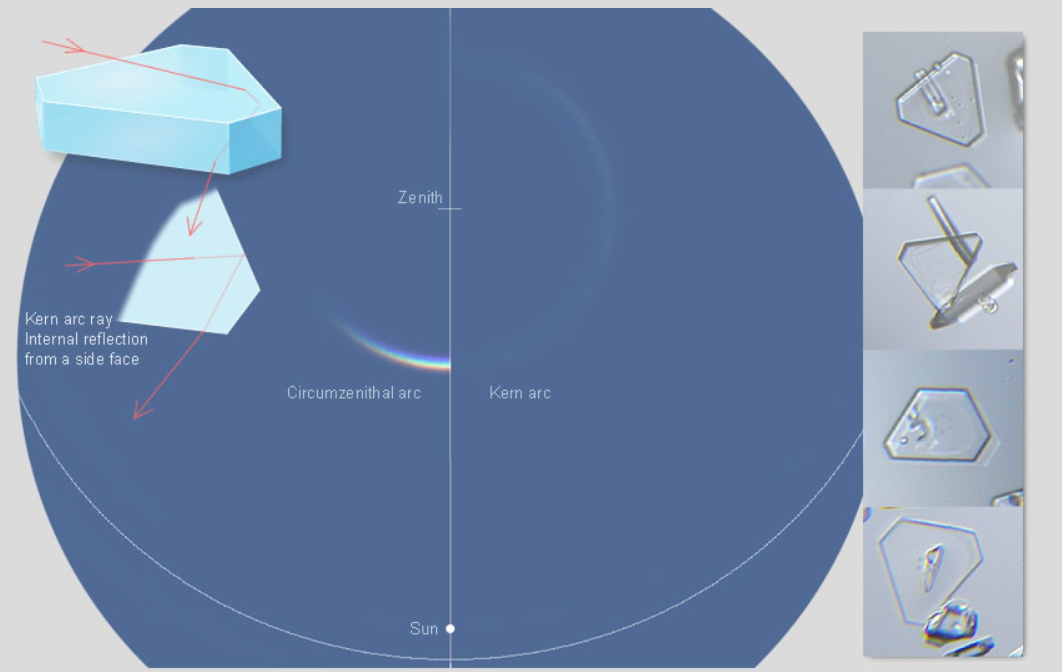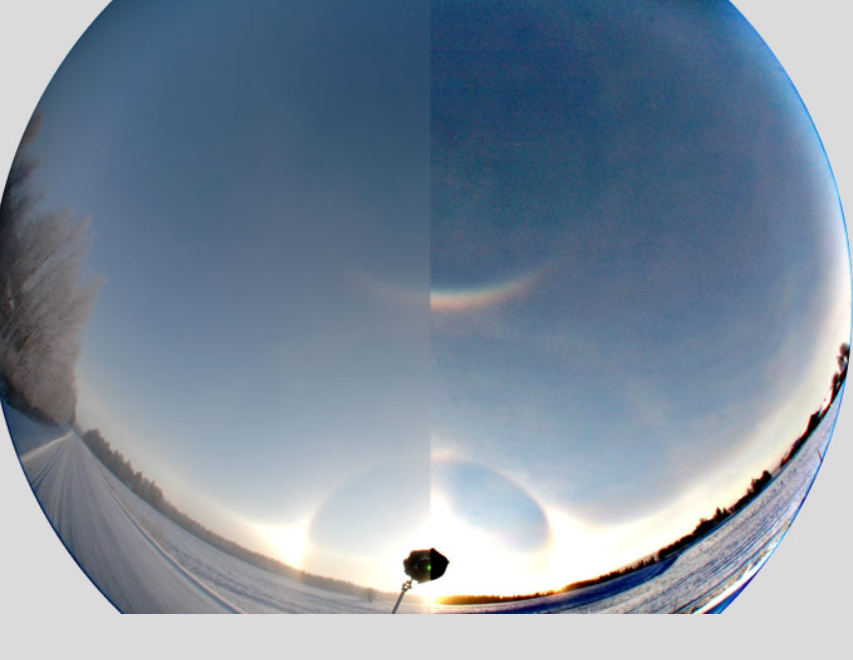Kern Arc
Kern Arc: A Rare and Enigmatic Atmospheric Phenomenon
Atmospheric optics never fails to surprise us with its stunning displays of light and color. One such rare and enigmatic phenomenon is the Kern arc. While the circumzenithal arc is more familiar, the Kern arc takes the concept to a whole new level. In this article, we will explore the fascinating world of the Kern arc, its formation, and its elusive nature.
Unveiling the Kern Arc: Capturing an Elusive Beauty
On November 17th, 2007, Marko Mikkilä, an avid atmospheric optics observer, captured the first-ever images of the Kern arc in Sotkamo, Finland. This extraordinary event marked a significant milestone in our understanding of this elusive optical phenomenon. The Kern arc appears as a faint upper circle, with the lower and brighter part being the more familiar circumzenithal arc. Mikkilä's images, obtained through a wide-angle fisheye lens and a stack of 16 individual images, brought out the intricate details of the Kern arc that were previously unseen.
The Distinctive Characteristics of the Kern Arc
What sets the Kern arc apart from its more common counterpart, the circumzenithal arc? While the circumzenithal arc only partially encircles the zenith, the Kern arc forms a complete circle around it. Visual sightings of the Kern arc have been reported on very few occasions, with the famous Saskatoon display of 1970 being one such instance. However, it had never been photographed until Mikkilä's groundbreaking achievement.
Understanding the Formation of the Kern Arc
To understand how the Kern arc is formed, we need to delve into the intricate workings of light rays within ice crystals present in the atmosphere. Like the circumzenithal arc, the Kern arc is also formed by rays entering the top faces of horizontal plate crystals and exiting through a near-vertical side face. However, the Kern arc rays undergo an internal reflection off a side face inclined at 60 degrees to the exit face. This contorted ray path is not possible in ordinary near-regular hexagonal crystals, unless they possess an improbable thickness, resembling vertical columns. The presence of near-"triangular" hexagonal crystals with three alternate side faces much shorter than the others allows the Kern rays to manifest more readily.
The Role of Crystal Shape in Kern Arc Formation
During the diamond dust display, Marko Mikkilä had the opportunity to sample ice crystals and examine their shapes. Many of these crystals exhibited the required near-"triangular" shape with three shorter alternate side faces. These peculiar crystal shapes provided the perfect conditions for the formation of the Kern arc. By studying these samples, Mikkilä was able to gain valuable insights into the unique characteristics of the Kern arc.
Revealing the Kern Arc Through Ray Tracing Simulations
To further comprehend the behavior of the Kern arc, researchers have employed ray tracing simulations. By simulating the path of light rays under specific solar elevations, these simulations shed light on the intricate details of the Kern arc's appearance. One such simulation, known as HaloSim, revealed that the Kern arc is not uniformly bright at all angles around the zenith. This finding aligns with Mikkilä's images, which also exhibit variations in brightness along the arc.
Unlocking the Mysteries of the Kern Arc
The discovery and documentation of the Kern arc by Marko Mikkilä have opened up new avenues for atmospheric optics research. By unraveling the mysteries surrounding this rare phenomenon, scientists can gain a deeper understanding of the complex interplay between light and ice crystals in our atmosphere. The study of the Kern arc not only contributes to our knowledge of atmospheric optics but also serves as a reminder of the breathtaking beauty that nature can bestow upon us.
In conclusion, the Kern arc stands as a testament to the wonders of our natural world. Its rarity and elusive nature make it a true marvel to behold. Through the pioneering work of Marko Mikkilä and advancements in ray tracing simulations, we are gradually unraveling the secrets of this captivating atmospheric phenomenon. As we continue to explore and study the Kern arc, we can look forward to uncovering even more of its hidden intricacies and adding to our ever-growing understanding of the mesmerizing world of atmospheric optics.

First ever images of a Kern arc captured by Marko Mikkilä at Sotkamo, Finland on 17th November 2007. The extremely rare Kern arc is the faint upper circle. The circle's lower and brighter part is the familiar circumzenithal arc. Mouse over the thumbnail for a labeled and unsharp masked version. The wide angle fisheye view is a stack of 16 individual images. Stacking brings out faint arcs whilst smoothing ambiguous variations in sky background. The Kern arc is also visible in individual images as in the example below.
The Kern arc completely encircles the zenith whereas the more familiar circumzenithal arc only partially does so. Visual sightings have been reported on a very few occasions including during the famous Saskatoon display of 1970. However, it has never before been photographed and Marko Mikkilä's images are a triumph.

"Triangular" plates sampled by Marko Mikkilä during the display.
The Kern arc is closely related to the circumzenithal arc. Like the latter, it is formed by rays entering the top faces of horizontal plate crystals and leaving through a near vertical side face. However, Kern arc rays undergo an internal reflection off a side face inclined at 60 degrees to the exit face. The contorted ray path is not possible in ordinary near regular hexagonal crystals unless they are improbably thick ~ vertical columns almost. Near "triangular" hexagonal crystals with three alternate side faces much shorter than the others allow Kern rays more readily. Marko Mikkilä sampled crystals during the diamond dust display and many had the required shape.
The HaloSim ray tracing simulation for the corresponding solar elevation of 6.2° is in two parts. The left hand side was filtered so that only rays entering a top face and leaving without any internal reflection registered. This shows the conventional circumzenithal arc. The right hand pane shows only rays undergoing at least one internal reflection from a side face. The resulting Kern arc is not uniformly bright at all angles around the zenith as indeed Mikkila’s images also shown

Single frame image showing the Kern arc.
The left hand is unenhanced, the right hand side is unsharp masked.
Note: this article has been automatically converted from the old site and may not appear as intended. You can find the original article here.
Reference Atmospheric Optics
If you use any of the definitions, information, or data presented on Atmospheric Optics, please copy the link or reference below to properly credit us as the reference source. Thank you!
-
<a href="https://atoptics.co.uk/blog/kern-arc/">Kern Arc</a>
-
"Kern Arc". Atmospheric Optics. Accessed on December 22, 2024. https://atoptics.co.uk/blog/kern-arc/.
-
"Kern Arc". Atmospheric Optics, https://atoptics.co.uk/blog/kern-arc/. Accessed 22 December, 2024
-
Kern Arc. Atmospheric Optics. Retrieved from https://atoptics.co.uk/blog/kern-arc/.